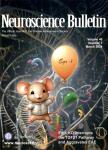Involvement of NF-κB and the CX3CR1 Signaling Network in Mechanical Allodynia Induced by Tetanic Sciatic Stimulation
Involvement of NF-κB and the CX3CR1 Signaling Network in Mechanical Allodynia Induced by Tetanic Sciatic Stimulation作者机构:Institutes of Brain Science State Key Laboratory of Medical Neurobiology and Collaborative Innovation Center for Brain Science Fudan University Department of Anesthesiology Fudan University Shanghai Cancer Center Department of Oncology Shanghai Medical College Fudan University
出 版 物:《Neuroscience Bulletin》 (神经科学通报(英文版))
年 卷 期:2018年第34卷第1期
页 面:64-73页
核心收录:
学科分类:0710[理学-生物学] 1002[医学-临床医学] 1001[医学-基础医学(可授医学、理学学位)] 100204[医学-神经病学] 10[医学]
基 金:supported by the National Natural Science Foundation of China(81471130,31420103903,and 31421091) a Development Project of Shanghai Peak Disciplines Integrated Chinese and Western Medicine
主 题:CX3CR1 Mechanical allodynia NF-κB Tetanic sciatic stimulation Microglia Spinal dorsal horn
摘 要:Tetanic stimulation of the sciatic nerve (TSS) triggers long-term potentiation in the dorsal horn of the spinal cord and long-lasting pain hypersensitivity. CX3CL1- CX3CR1 signaling is an important pathway in neuronal- microglial activation. Nuclear factor nB (NF-KB) is a key signal transduction molecule that regulates neuroinflamma- tion and neuropathic pain. Here, we set out to determine whether and how NF-~B and CX3CR1 are involved in the mechanism underlying the pathological changes induced by TSS. After unilateral TSS, significant bilateral mechanical allodynia was induced, as assessed by the von Frey test. The expression of phosphorylated NF-nB (pNF-nB) and CX3CR1 was significantly up-regulated in the bilateral dorsal horn. Immunofluorescence staining demonstrated that pNF-κB and NeuN co-existed, implying that the NF-κB pathway is predominantly activated in neurons following TSS. Administration of either the NF-κB inhibitor ammo- nium pyrrolidine dithiocarbamate or a CX3CR1-neutralizing antibody blocked the development and maintenance of neuropathic pain. In addition, blockade of NF-κB down- regulated the expression of CX3CL1-CX3CR1 signaling,and conversely the CX3CRl-neutralizing antibody also down-regulated pNF-rd3. These findings suggest an involvement of NF-κB and the CX3CR1 signaling network in the development and maintenance of TSS-induced mechanical allodynia. Our work suggests the potential clinical application of NF-κB inhibitors or CX3CR 1-neutralizing antibodies in treating pathological pain.



